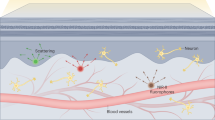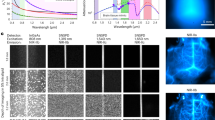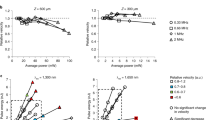Abstract
Light scattering by biological tissues sets a limit to the penetration depth of high-resolution optical microscopy imaging of live mammals in vivo. An effective approach to reduce light scattering and increase imaging depth is to extend the excitation and emission wavelengths to the second near-infrared window (NIR-II) at >1,000 nm, also called the short-wavelength infrared window. Here we show biocompatible core–shell lead sulfide/cadmium sulfide quantum dots emitting at ~1,880 nm and superconducting nanowire single-photon detectors for single-photon detection up to 2,000 nm, enabling a one-photon excitation fluorescence imaging window in the 1,700–2,000 nm (NIR-IIc) range with 1,650 nm excitation—the longest one-photon excitation and emission for in vivo mouse imaging so far. Confocal fluorescence imaging in NIR-IIc reached an imaging depth of ~1,100 μm through an intact mouse head, and enabled non-invasive cellular-resolution imaging in the inguinal lymph nodes of mice without any surgery. We achieve in vivo molecular imaging of high endothelial venules with diameters as small as ~6.6 μm, as well as CD169 + macrophages and CD3 + T cells in the lymph nodes, opening the possibility of non-invasive intravital imaging of immune trafficking in lymph nodes at the single-cell/vessel-level longitudinally.
This is a preview of subscription content, access via your institution
Access options
Access Nature and 54 other Nature Portfolio journals
Get Nature+, our best-value online-access subscription
$29.99 / 30 days
cancel any time
Subscribe to this journal
Receive 12 print issues and online access
$259.00 per year
only $21.58 per issue
Buy this article
- Purchase on Springer Link
- Instant access to full article PDF
Prices may be subject to local taxes which are calculated during checkout




Similar content being viewed by others
Data availability
Source data are provided with this paper. All data that support the findings of this study are presented in the main text and the Supplementary Information. Source Data are provided with this paper.
References
Horton, N. G. et al. In vivo three-photon microscopy of subcortical structures within an intact mouse brain. Nat. Photon. 7, 205–209 (2013).
Yildirim, M., Sugihara, H., So, P. T. C. & Sur, M. Functional imaging of visual cortical layers and subplate in awake mice with optimized three-photon microscopy. Nat. Commun. 10, 177 (2019).
Kobat, D., Horton, N. & Xu, C. In vivo two-photon microscopy to 1.6-mm depth in mouse cortex. J. Biomed. Opt. 16, 106014 (2011).
Miller, M. J., Wei, S. H., Parker, I. & Cahalan, M. D. Two-photon imaging of lymphocyte motility and antigen response in intact lymph node. Science 296, 1869–1873 (2002).
Helmchen, F. & Denk, W. Deep tissue two-photon microscopy. Nat. Methods 2, 932–940 (2005).
Svoboda, K. & Yasuda, R. Principles of two-photon excitation microscopy and its applications to neuroscience. Neuron 50, 823–839 (2006).
Horton, N. G. & Xu, C. Dispersion compensation in three-photon fluorescence microscopy at 1,700 nm. Biomed. Opt. Exp. 6, 1392–1397 (2015).
Wang, T. et al. Three-photon imaging of mouse brain structure and function through the intact skull. Nat. Methods 15, 789–792 (2018).
Yang, Q. et al. Donor engineering for NIR-II molecular fluorophores with enhanced fluorescent performance. J. Am. Chem. Soc. 140, 1715–1724 (2018).
Li, Y. et al. Design of AIEgens for near-infrared IIb imaging through structural modulation at molecular and morphological levels. Nat. Commun. 11, 1255 (2020).
Welsher, K. et al. A route to brightly fluorescent carbon nanotubes for near-infrared imaging in mice. Nat. Nanotechnol. 4, 773–780 (2009).
Zhang, M. et al. Bright quantum dots emitting at ∼1,600 nm in the NIR-IIb window for deep tissue fluorescence imaging. Proc. Natl Acad. Sci. USA 115, 6590–6595 (2018).
Bruns, O. T. et al. Next-generation in vivo optical imaging with short-wave infrared quantum dots. Nat. Biomed. Eng. 1, 0056 (2017).
Zhong, Y. et al. In vivo molecular imaging for immunotherapy using ultra-bright near-infrared-IIb rare-earth nanoparticles. Nat. Biotechnol. 37, 1322–1331 (2019).
Fan, Y. et al. Lifetime-engineered NIR-II nanoparticles unlock multiplexed in vivo imaging. Nat. Nanotechnol. 13, 941–946 (2018).
Naczynski, D. J. et al. Rare-earth-doped biological composites as in vivo shortwave infrared reporters. Nat. Commun. 4, 2199 (2013).
Zhu, S. et al. 3D NIR-II molecular imaging distinguishes targeted organs with high-performance NIR-II bioconjugates. Adv. Mater. 30, 1705799 (2018).
Wang, F. et al. Light-sheet microscopy in the near-infrared II window. Nat. Methods 16, 545–552 (2019).
Wang, F. et al. In vivo NIR-II structured-illumination light-sheet microscopy. Proc. Natl Acad. Sci. USA 118, e2023888118 (2021).
Wan, H. et al. A bright organic NIR-II nanofluorophore for three-dimensional imaging into biological tissues. Nat. Commun. 9, 1–9 (2018).
Golovynskyi, S. et al. Optical windows for head tissues in near-infrared and short-wave infrared regions: approaching transcranial light applications. J. Biophoton. 11, e201800141 (2018).
Hong, G. et al. Through-skull fluorescence imaging of the brain in a new near-infrared window. Nat. Photon. 8, 723–730 (2014).
Burrows, P. E. et al. Lymphatic abnormalities are associated with RASA1 gene mutations in mouse and man. Proc. Natl Acad. Sci. USA 110, 8621–8626 (2013).
Diao, S. et al. Fluorescence imaging in vivo at wavelengths beyond 1,500 nm. Angew. Chem. Int. Ed. 54, 14758–14762 (2015).
Pasko, J., Shin, S. & Cheung, D. Epitaxial HgCdTe/CdTe Photodiodes For The 1 to 3 pm Spectral Region 0282 TSE (SPIE, 1981).
Ren, F., Zhao, H., Vetrone, F. & Ma, D. Microwave-assisted cation exchange toward synthesis of near-infrared emitting PbS/CdS core/shell quantum dots with significantly improved quantum yields through a uniform growth path. Nanoscale 5, 7800–7804 (2013).
Ma, Z. et al. Cross‐link‐functionalized nanoparticles for rapid excretion in nanotheranostic applications. Angew. Chem. 132, 20733–20741 (2020).
Zichi, J. et al. Optimizing the stoichiometry of ultrathin NbTiN films for high-performance superconducting nanowire single-photon detectors. Opt. Exp. 27, 26579–26587 (2019).
Wang, L., Jacques, S. L. & Zheng, L. MCML—Monte Carlo modeling of light transport in multi-layered tissues. Comput. Meth. Prog. Biomed. 47, 131–146 (1995).
Herisson, F. et al. Direct vascular channels connect skull bone marrow and the brain surface enabling myeloid cell migration. Nat. Neurosci. 21, 1209–1217 (2018).
Pereira, E. R. et al. Lymph node metastases can invade local blood vessels, exit the node, and colonize distant organs in mice. Science 359, 1403–1407 (2018).
Sewald, X. et al. Retroviruses use CD169-mediated trans-infection of permissive lymphocytes to establish infection. Science 350, 563–567 (2015).
Milutinovic, S., Abe, J., Godkin, A., Stein, J. V. & Gallimore, A. The dual role of high endothelial venules in cancer progression versus immunity. Trends Cancer 7, 214–225 (2021).
Hoshino, H. et al. Apical membrane expression of distinct sulfated glycans represents a novel marker of cholangiolocellular carcinoma. Lab. Invest. 96, 1246–1255 (2016).
Fonsatti, E. & Maio, M. Highlights on endoglin (CD105): from basic findings towards clinical applications in human cancer. J. Transl. Med. 2, 18 (2004).
Gaya, M. et al. Inflammation-induced disruption of SCS macrophages impairs B cell responses to secondary infection. Science 347, 667–672 (2015).
Girard, J.-P., Moussion, C. & Förster, R. HEVs, lymphatics and homeostatic immune cell trafficking in lymph nodes. Nat. Rev. Immunol. 12, 762–773 (2012).
Gu, M., Gan, X., Kisteman, A. & Xu, M. G. Comparison of penetration depth between two-photon excitation and single-photon excitation in imaging through turbid tissue media. Appl. Phys. Lett. 77, 1551–1553 (2000).
Hu, C., Muller-Karger, F. E. & Zepp, R. G. Absorbance, absorption coefficient, and apparent quantum yield: a comment on common ambiguity in the use of these optical concepts. Limnol. Oceanogr. 47, 1261–1267 (2002).
Wang, M. et al. Comparing the effective attenuation lengths for long wavelength in vivo imaging of the mouse brain. Biomed. Opt. Exp. 9, 3534–3543 (2018).
Acknowledgements
This study was supported by the National Institutes of Health (NIH DP1-NS-105737, H.D.). We thank K. Taylor from JASCO who helped measuring the UV–vis–NIR absorbance spectrum of water using their V-770 Spectrophotometer. F.R. thanks the Fonds de recherche du Québec—Nature et technologies (FRQNT) for funding (F.R.). Single Quantum acknowledges support from the EIC SME Phase 2 project SQP (grant no. 848827 to R.G., J.W.L., A.F. and J.Q-.D.).
Author information
Authors and Affiliations
Contributions
H.D. and F.W. conceived and designed the experiments. H.D. and F.W. designed the optical system. F.W. set up the optical system. F.W., F.R. and Z.M. performed the experiments. F.R. synthesized the PbS/CdS QD. R.G., I.E.Z., J.W.N.L., A.F. and J.Q-.D. developed the SNSPD optimized in a 1,550–2,000 nm window. F.W., F.R., Z.M., L.Q., C.X., A.B., J.L. and H.D. analysed the data. F.W. and H.D. wrote the manuscript. All authors contributed to the general discussion and revision of the manuscript.
Corresponding author
Ethics declarations
Competing interests
The following authors were employed by Single Quantum and may profit financially: R.G., J.W.L., A.F. and J.Q.D.
Peer review
Peer review information
Nature Nanotechnology thanks Eva Sevick-Muraca, Wei Zheng and the other, anonymous, reviewer(s) for their contribution to the peer review of this work.
Additional information
Publisher’s note Springer Nature remains neutral with regard to jurisdictional claims in published maps and institutional affiliations.
Supplementary information
Supplementary Information
Supplementary Notes 1–3, Figs. 1–18 and Tables 1–3.
Supplementary Video
Animated mouse brain video from non-invasive in vivo NIR-IIc confocal microscopy images of vasculatures in intact mouse head.
Source data
Source Data Fig. 3
Statistical Source Data for Fig. 3e.
Rights and permissions
About this article
Cite this article
Wang, F., Ren, F., Ma, Z. et al. In vivo non-invasive confocal fluorescence imaging beyond 1,700 nm using superconducting nanowire single-photon detectors. Nat. Nanotechnol. 17, 653–660 (2022). https://doi.org/10.1038/s41565-022-01130-3
Received:
Accepted:
Published:
Issue Date:
DOI: https://doi.org/10.1038/s41565-022-01130-3
This article is cited by
-
Silicon-RosIndolizine fluorophores with shortwave infrared absorption and emission profiles enable in vivo fluorescence imaging
Nature Chemistry (2024)
-
Near-infrared II fluorescence imaging
Nature Reviews Methods Primers (2024)
-
In vivo NIR-II fluorescence imaging for biology and medicine
Nature Photonics (2024)
-
Noninvasive in vivo microscopy of single neutrophils in the mouse brain via NIR-II fluorescent nanomaterials
Nature Protocols (2024)
-
Nanovaccine-based strategies for lymph node targeted delivery and imaging in tumor immunotherapy
Journal of Nanobiotechnology (2023)



